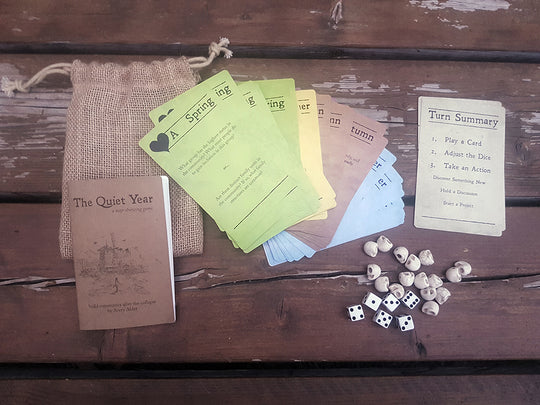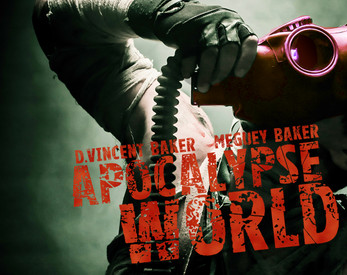A Quiet Year Post-Apocalyptic; Environmental; Narrative-Driven; Collaborative Worldbuilding; Innovative Mechanics; Survival; Solo Play
'A Quiet Year' is a unique tabletop roleplaying game that blends narrative-driven gameplay with collaborative worldbuilding, set in a post-apocalyptic environment. Players guide a community through the challenges of survival during a single year following a cataclysmic event, using a deck of cards to dictate weekly events and shape the story. The game's innovative mechanics, focus on community, and open-ended nature distinguish it from traditional RPGs, making it appealing to players interested in collaborative storytelling and emergent narratives. This report will delve into the game's themes, mechanics, unique elements, and target audience.
Theme and Setting
The central theme of 'A Quiet Year' revolves around community resilience and the struggle for survival in a post-apocalyptic setting. The game plunges players into the aftermath of a collapse, tasking them with guiding a community through a year of rebuilding and preparation before the arrival of the ominous Frost Shepherds. The environment is inherently uncertain and challenging, marked by scarcity, conflict, and the constant need for adaptation. The setting is collaboratively defined; players begin by establishing the community's initial resources (one abundant, the others scarce) and drawing the starting features on a shared map, which emphasizes the importance of the physical space and its influence on the narrative. This map serves as a living record of the community's progress, struggles, and evolving identity. The shared worldbuilding fosters a sense of ownership and investment among the players, making the community's fate all the more impactful.
Core Mechanics and Rules
The core mechanic of 'A Quiet Year' is driven by a standard deck of 52 playing cards, with each card representing a week in the titular year. Every player draws a card on their turn and must interpret its prompt, allowing it to shape the unfolding narrative. The card prompts vary depending on the season, with spring focusing on community questions, summer introducing nuance, autumn bringing decay and strife, and winter presenting unpredictable challenges. After resolving the card's prompt, players have a choice of three actions: starting a project (constructing or repairing something for the community), holding a discussion (briefly debating community priorities with limited interaction), or announcing a discovery (adding a new element or location to the map). Projects are tracked with dice, counting down the weeks required for completion, while discussions are deliberately constrained to simulate the frustrations of community decision-making. 'Contempt tokens' allow players to express dissatisfaction with decisions, adding another layer of social dynamics to the game. This framework, characterized by structured turns and limited verbal interaction, compels players to consider the consequences of their actions and contribute meaningfully to the shared narrative.
What Makes It Unique
'A Quiet Year' distinguishes itself from traditional tabletop RPGs through its innovative blend of collaborative worldbuilding, narrative prompts, and limited player interaction. The game is GM-less, meaning there is no single designated storyteller; instead, the story emerges organically from the interactions between players and the card prompts. The focus on a community, rather than individual characters, fosters a sense of collective responsibility and shared investment in the game's outcome. Furthermore, the cartographic element encourages visual storytelling and reinforces the importance of place in shaping the narrative. The limited communication during discussions, enforced by the turn-based structure, simulates the complexities and frustrations of community decision-making. This constraint, coupled with the use of 'contempt tokens', adds a unique social dynamic rarely found in other RPGs. The game's design pushes players to consider the broader implications of their choices on the community's well-being and future, fostering a deeper appreciation for the challenges of collective survival.
Target Audience and Player Experience
The target audience for 'A Quiet Year' includes tabletop RPG enthusiasts who appreciate narrative-driven gameplay, collaborative worldbuilding, and innovative mechanics. It particularly appeals to players interested in exploring themes of community, resilience, and the consequences of societal collapse. The game is suitable for 2-4 players and typically lasts 3-4 hours, making it ideal for one-shot sessions or shorter campaigns. The player experience is characterized by a mix of creativity, strategic decision-making, and social interaction. Players must collaborate to define the world, manage resources, and resolve conflicts, while also grappling with the challenges presented by the card prompts. The limited communication can be frustrating for some, but it also encourages players to be more thoughtful and deliberate in their contributions. Ultimately, 'A Quiet Year' offers a unique and rewarding experience for players who enjoy emergent storytelling, collaborative worldbuilding, and exploring complex themes within a structured framework. The game also supports solo play, offering a compelling experience for those who enjoy worldbuilding and narrative creation without a group.



